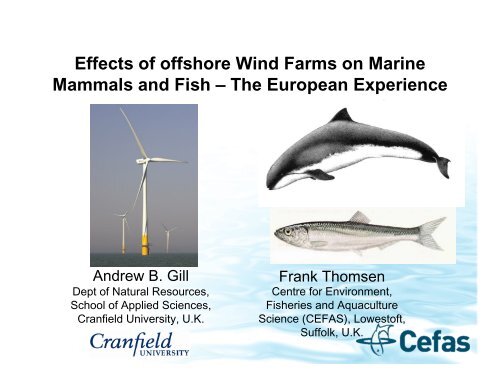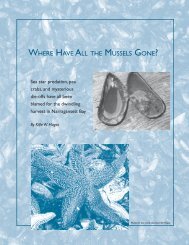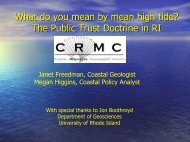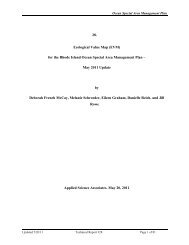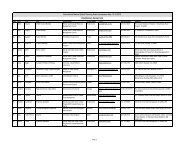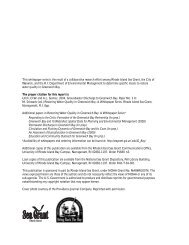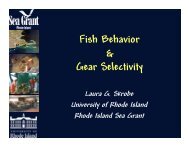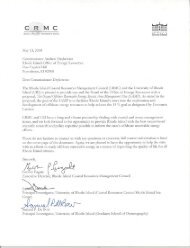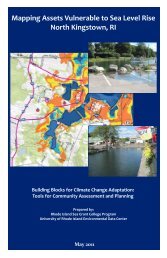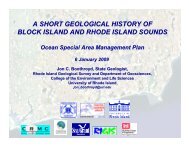Effects of offshore Wind Farms on Marine Mammals and Fish â The ...
Effects of offshore Wind Farms on Marine Mammals and Fish â The ...
Effects of offshore Wind Farms on Marine Mammals and Fish â The ...
You also want an ePaper? Increase the reach of your titles
YUMPU automatically turns print PDFs into web optimized ePapers that Google loves.
<str<strong>on</strong>g>Effects</str<strong>on</strong>g> <str<strong>on</strong>g>of</str<strong>on</strong>g> <str<strong>on</strong>g>of</str<strong>on</strong>g>fshore <str<strong>on</strong>g>Wind</str<strong>on</strong>g> <str<strong>on</strong>g>Farms</str<strong>on</strong>g> <strong>on</strong> <strong>Marine</strong><br />
<strong>Mammals</strong> <strong>and</strong> <strong>Fish</strong> – <strong>The</strong> European Experience<br />
Andrew B. Gill<br />
Dept <str<strong>on</strong>g>of</str<strong>on</strong>g> Natural Resources,<br />
School <str<strong>on</strong>g>of</str<strong>on</strong>g> Applied Sciences,<br />
Cranfield University, U.K.<br />
Frank Thomsen<br />
Centre for Envir<strong>on</strong>ment,<br />
<strong>Fish</strong>eries <strong>and</strong> Aquaculture<br />
Science (CEFAS), Lowest<str<strong>on</strong>g>of</str<strong>on</strong>g>t,<br />
Suffolk, U.K.
(Adrian Judd, with permissi<strong>on</strong>)
Round 3
Spatial & Temporal c<strong>on</strong>siderati<strong>on</strong>s<br />
Extent <str<strong>on</strong>g>of</str<strong>on</strong>g> development<br />
• Multiple devices<br />
• Cable array<br />
• Sub-stati<strong>on</strong> & c<strong>on</strong>necti<strong>on</strong> to shore<br />
• Envir<strong>on</strong>mental footprint<br />
• Other wind farms & renewable opti<strong>on</strong>s<br />
Time scale <str<strong>on</strong>g>of</str<strong>on</strong>g> development<br />
Other uses <str<strong>on</strong>g>of</str<strong>on</strong>g> the coastal z<strong>on</strong>e<br />
•©Elsam A/S
Phases <str<strong>on</strong>g>of</str<strong>on</strong>g> impacts <str<strong>on</strong>g>of</str<strong>on</strong>g> ecological relevance<br />
1. C<strong>on</strong>structi<strong>on</strong> (& survey)<br />
3. Decommissi<strong>on</strong><br />
2. Operati<strong>on</strong><br />
©GE wind energy
<str<strong>on</strong>g>Effects</str<strong>on</strong>g> & impacts <str<strong>on</strong>g>of</str<strong>on</strong>g> ecological relevance<br />
ORED Activity<br />
C<strong>on</strong>structi<strong>on</strong><br />
-energy c<strong>on</strong>versi<strong>on</strong><br />
device<br />
- substati<strong>on</strong><br />
-cables<br />
Operati<strong>on</strong><br />
Decommissi<strong>on</strong><br />
ORED = Offshore renewable energy developments
<str<strong>on</strong>g>Effects</str<strong>on</strong>g> & impacts <str<strong>on</strong>g>of</str<strong>on</strong>g> ecological relevance<br />
ORED Activity<br />
Effectors<br />
C<strong>on</strong>structi<strong>on</strong><br />
-energy c<strong>on</strong>versi<strong>on</strong><br />
device<br />
- substati<strong>on</strong><br />
-cables<br />
Operati<strong>on</strong><br />
Sediment – removal<br />
- disturbance<br />
Cable - laying<br />
- routing<br />
Structure - type<br />
-scale<br />
- pile driving<br />
Areal extent<br />
Timing <str<strong>on</strong>g>of</str<strong>on</strong>g> activity<br />
Cable - rating<br />
- array c<strong>on</strong>figurati<strong>on</strong><br />
Electricity - amount<br />
- frequency<br />
- variability<br />
Moving parts<br />
Structure – type<br />
- scale<br />
Decommissi<strong>on</strong><br />
Sediment disturbance<br />
Structure removal<br />
Cable removal<br />
Areal extent<br />
Timing <str<strong>on</strong>g>of</str<strong>on</strong>g> activity<br />
ORED = Offshore renewable energy developments
<str<strong>on</strong>g>Effects</str<strong>on</strong>g> & impacts <str<strong>on</strong>g>of</str<strong>on</strong>g> ecological relevance<br />
ORED Activity Effectors <str<strong>on</strong>g>Effects</str<strong>on</strong>g> <strong>on</strong> Coastal<br />
Envir<strong>on</strong>ment<br />
C<strong>on</strong>structi<strong>on</strong><br />
-energy c<strong>on</strong>versi<strong>on</strong><br />
device<br />
- substati<strong>on</strong><br />
-cables<br />
Operati<strong>on</strong><br />
Sediment – removal<br />
- disturbance<br />
Cable - laying<br />
- routing<br />
Structure - type<br />
-scale<br />
- pile driving<br />
Areal extent<br />
Timing <str<strong>on</strong>g>of</str<strong>on</strong>g> activity<br />
Cable - rating<br />
- array c<strong>on</strong>figurati<strong>on</strong><br />
Electricity - amount<br />
- frequency<br />
- variability<br />
Moving parts<br />
Structure – type<br />
- scale<br />
Habitat removal<br />
Smothering - species<br />
- habitat<br />
Increased turbidity<br />
C<strong>on</strong>taminant remobilisati<strong>on</strong><br />
Increased Biol Oxygen Dem<strong>and</strong><br />
Increased noise & vibrati<strong>on</strong><br />
Noise & vibrati<strong>on</strong><br />
Electromagnetic field (EMF)<br />
- frequency<br />
- amplitude<br />
Collisi<strong>on</strong> - above water<br />
-below water<br />
Increased habitat heterogeneity<br />
- col<strong>on</strong>isati<strong>on</strong> opportunity<br />
Sediment transport<br />
Water movement characteristics<br />
Decommissi<strong>on</strong><br />
Sediment disturbance<br />
Structure removal<br />
Cable removal<br />
Areal extent<br />
Timing <str<strong>on</strong>g>of</str<strong>on</strong>g> activity<br />
Habitat removal<br />
Smothering - species<br />
- habitat<br />
Increased turbidity<br />
C<strong>on</strong>taminant remobilisati<strong>on</strong><br />
Increased Biol Oxygen Dem<strong>and</strong><br />
Decreased habitat heterogeneity<br />
New col<strong>on</strong>isati<strong>on</strong> opportunity<br />
Increased noise & vibrati<strong>on</strong><br />
ORED = Offshore renewable energy developments
<str<strong>on</strong>g>Effects</str<strong>on</strong>g> & impacts <str<strong>on</strong>g>of</str<strong>on</strong>g> ecological relevance<br />
ORED Activity Effectors <str<strong>on</strong>g>Effects</str<strong>on</strong>g> <strong>on</strong> Coastal<br />
Envir<strong>on</strong>ment<br />
Potential Ecological<br />
Resp<strong>on</strong>se<br />
C<strong>on</strong>structi<strong>on</strong><br />
-energy c<strong>on</strong>versi<strong>on</strong><br />
device<br />
-substati<strong>on</strong><br />
-cables<br />
Sediment – removal<br />
- disturbance<br />
Cable - laying<br />
- routing<br />
Structure - type<br />
-scale<br />
- pile driving<br />
Areal extent<br />
Timing <str<strong>on</strong>g>of</str<strong>on</strong>g> activity<br />
Habitat removal<br />
Smothering - species<br />
- habitat<br />
Increased turbidity<br />
C<strong>on</strong>taminant remobilisati<strong>on</strong><br />
Increased Biol Oxygen.Dem<strong>and</strong><br />
Increased noise & vibrati<strong>on</strong><br />
Sedentary species:<br />
Reduced diversity<br />
Increase in opportunist<br />
abundance<br />
Mobile species:<br />
Temporary displacement<br />
L<strong>on</strong>g-term displacement<br />
Hearing loss<br />
Indirect effects<br />
Operati<strong>on</strong><br />
Cable - rating<br />
- array c<strong>on</strong>figurati<strong>on</strong><br />
Electricity - amount<br />
- frequency<br />
- variability<br />
Moving parts<br />
Structure – type<br />
- scale<br />
Noise & vibrati<strong>on</strong><br />
Electromagnetic field (EMF)<br />
- frequency<br />
- amplitude<br />
Collisi<strong>on</strong> - above water<br />
-below water<br />
Increased habitat heterogeneity<br />
- col<strong>on</strong>isati<strong>on</strong> opportunity<br />
Sediment transport<br />
Water movement characteristics<br />
Acoustic species:<br />
Individual disturbance<br />
Populati<strong>on</strong> disturbance<br />
EMF sensitive species:<br />
Individual attracti<strong>on</strong>/avoidance<br />
Populati<strong>on</strong> attracti<strong>on</strong>/avoidance<br />
Altered migrati<strong>on</strong> - temporary<br />
- l<strong>on</strong>g term<br />
Injury/fatality <str<strong>on</strong>g>of</str<strong>on</strong>g> individuals<br />
Changes to - diversity<br />
- abundance<br />
-biomass<br />
- c<strong>on</strong>nectivity<br />
- community structure<br />
Indirect effects<br />
Decommissi<strong>on</strong><br />
Sediment disturbance<br />
Structure removal<br />
Cable removal<br />
Areal extent<br />
Timing <str<strong>on</strong>g>of</str<strong>on</strong>g> activity<br />
Habitat removal<br />
Smothering - species<br />
- habitat<br />
Increased turbidity<br />
C<strong>on</strong>taminant remobilisati<strong>on</strong><br />
Increased Biol Oxygen Dem<strong>and</strong><br />
Decreased habitat heterogeneity<br />
New col<strong>on</strong>isati<strong>on</strong> opportunity<br />
Increased noise & vibrati<strong>on</strong><br />
Sedentary species:<br />
Reduced diversity<br />
Increase in opportunist<br />
abundance<br />
Mobile species:<br />
Temporary displacement<br />
L<strong>on</strong>g-term displacement<br />
Reducti<strong>on</strong> in biomass<br />
Indirect effects<br />
ORED = Offshore renewable energy developments<br />
Source: Gill (2005) Journal <str<strong>on</strong>g>of</str<strong>on</strong>g> Applied Ecology 42, p605-615<br />
615
Investigating potential interacti<strong>on</strong>s between<br />
marine organisms <strong>and</strong> <str<strong>on</strong>g>of</str<strong>on</strong>g>fshore wind energy<br />
Baseline underst<strong>and</strong>ing <str<strong>on</strong>g>of</str<strong>on</strong>g> the organisms <str<strong>on</strong>g>of</str<strong>on</strong>g><br />
interest<br />
C<strong>on</strong>sider the different phases<br />
• Installati<strong>on</strong><br />
• Operati<strong>on</strong><br />
• Decommissi<strong>on</strong>ing<br />
Appropriate spatial scale<br />
Appropriate temporal scale<br />
Policy driven (eg. EIA & MSFD)<br />
Relevance to <str<strong>on</strong>g>of</str<strong>on</strong>g>fshore industry, regulators,<br />
other stakeholders
COWRIE studies<br />
- taking the lab out into the field<br />
• Set out the research questi<strong>on</strong> to answer (e.g.)<br />
Q. Do electromagnetic sensitive fish resp<strong>on</strong>d to EMF emitted by <str<strong>on</strong>g>of</str<strong>on</strong>g>fshore<br />
wind farm cables?<br />
Q. Does pile driving affect the behaviour <str<strong>on</strong>g>of</str<strong>on</strong>g> marine fish<br />
• Mesocosm (large fish pen) based study<br />
• Focus <strong>on</strong> semi-realism<br />
but study c<strong>on</strong>trol<br />
• Remote coastal site away from background EMF & noise<br />
• Relevant species with different attributes<br />
• Behavioural study with remote methods<br />
Photo: Rachel Ball<br />
www.ices.dk/marineworld/jaws.asp
Navigati<strong>on</strong><br />
marker buoys<br />
COWRIE Mesocosm Studies<br />
Sea surface<br />
Floating<br />
polyethylene<br />
collar<br />
Buoyancy<br />
Zip access<br />
10-15m<br />
5m<br />
40m<br />
Bridle mooring<br />
to mesocosm 2<br />
Sinkable<br />
polyethylene<br />
collar<br />
v<br />
Anchors/mooring<br />
Flat, s<strong>and</strong>y<br />
sea bed
A large-scale experiment to<br />
determine the resp<strong>on</strong>se <str<strong>on</strong>g>of</str<strong>on</strong>g><br />
electrosensitive fish to<br />
electromagnetic fields (EMF)<br />
generated by <str<strong>on</strong>g>of</str<strong>on</strong>g>fshore<br />
windfarms<br />
Andrew B. Gill 1 *, Ian Gloyne-Phillips 3 , Yi Huang 4 , Julian<br />
Metcalfe 2 , Andrew Pate 4 , Joe Spencer 4 , Vicky Quayle 2 &<br />
Victoria Wearmouth 1<br />
1 – Cranfield University; 2 – Centre for <strong>Fish</strong>eries, Envir<strong>on</strong>ment <strong>and</strong><br />
Aquaculture Science (CEFAS), 3 - CMACS Ltd, 4 – Centre for<br />
Intelligent M<strong>on</strong>itoring Systems (CIMS), University <str<strong>on</strong>g>of</str<strong>on</strong>g> Liverpool
Electromagnetic field (EMF)<br />
emissi<strong>on</strong>s from wind farm cables<br />
X-secti<strong>on</strong> cable (internal) –<br />
magnetic field<br />
X-secti<strong>on</strong> cable (external)<br />
-magnetic field
Magnetic fields<br />
<strong>Fish</strong> (comm<strong>on</strong> eels & salm<strong>on</strong>ids)<br />
• Focus - migrati<strong>on</strong> behaviour<br />
- behaviour in relati<strong>on</strong><br />
to the cable trace<br />
Chel<strong>on</strong>ians (turtles)<br />
Cetaceans (whales & dolphins)<br />
Pinnipeds (seals)<br />
Crustaceans (crabs & lobsters)
Elasmobranchs (sharks, skates <strong>and</strong> rays) –<br />
Electro- & Magneto-recepti<strong>on</strong><br />
Elasmobranchs (sharks, skates <strong>and</strong> rays) – key predators in<br />
coastal ecosystems <strong>and</strong> increasing c<strong>on</strong>servati<strong>on</strong> c<strong>on</strong>cern
Density distributi<strong>on</strong> <str<strong>on</strong>g>of</str<strong>on</strong>g> Thornback Ray, functi<strong>on</strong>al<br />
benthic habitat & <str<strong>on</strong>g>of</str<strong>on</strong>g>fshore wind farm sites
EMF emissi<strong>on</strong>s from AC windfarm<br />
cables<br />
Magnetic field<br />
Induced electric field<br />
• Approximates to E field <str<strong>on</strong>g>of</str<strong>on</strong>g> 0.9μV/cm (50 Hz)<br />
at surface <str<strong>on</strong>g>of</str<strong>on</strong>g> seabed
Measured electric <strong>and</strong> magnetic field <str<strong>on</strong>g>of</str<strong>on</strong>g><br />
operati<strong>on</strong>al wind farm cable
Resp<strong>on</strong>se to E-field<br />
Elasmobranchs E field detecti<strong>on</strong> range: 10μV/cm – 5nV/cm<br />
(variable low frequencies)
Potential effects?<br />
-working hypothesis<br />
Al<strong>on</strong>g/over the cable trace<br />
Within the cable array
Movement tracking<br />
(Figure © by Vemco)
Fine scale movement <str<strong>on</strong>g>of</str<strong>on</strong>g> ray<br />
during 3 hour event<br />
Variables<br />
-Near Distance<br />
-Step length
Mean Step length (+/-95%C.L.) <str<strong>on</strong>g>of</str<strong>on</strong>g> individual rays<br />
2.50<br />
Live<br />
*<br />
2.00<br />
*<br />
Mean Step length (m)<br />
1.50<br />
1.00<br />
*<br />
0<br />
1<br />
2<br />
0.50<br />
0.00<br />
8353RcT3 8355RcT3 8353RcT2 8356RcT1<br />
<strong>Fish</strong> individual <strong>and</strong> Trial
EMF at wind farms-<br />
• Both electric <strong>and</strong> magnetic<br />
fields are emitted by OWF<br />
cables<br />
EMF C<strong>on</strong>clusi<strong>on</strong>s<br />
Individual effects-<br />
• EM sensitive fish can detect<br />
EMF from subsea AC cables<br />
• Variable resp<strong>on</strong>se by individuals<br />
• Attracted to emissi<strong>on</strong> at lower end <str<strong>on</strong>g>of</str<strong>on</strong>g> range<br />
<str<strong>on</strong>g>of</str<strong>on</strong>g> sensitivity<br />
Populati<strong>on</strong> effects-<br />
• Need to determine if this<br />
attracti<strong>on</strong> is repetitive<br />
• Does avoidance occurs at<br />
higher emissi<strong>on</strong>s <str<strong>on</strong>g>of</str<strong>on</strong>g> EMF
Underwater sound<br />
• Four times faster than air<br />
• Less attenuati<strong>on</strong><br />
• Very l<strong>on</strong>g ranges (SOFAR<br />
channel = > 1,000 km)
Sound <strong>and</strong> marine life
Functi<strong>on</strong>s <str<strong>on</strong>g>of</str<strong>on</strong>g> sound for marine life<br />
Communicati<strong>on</strong><br />
Finding food<br />
Stunning prey<br />
Eavesdropping<br />
Navigati<strong>on</strong>
<strong>The</strong>oretical z<strong>on</strong>es <str<strong>on</strong>g>of</str<strong>on</strong>g> noise influence<br />
Detecti<strong>on</strong><br />
Masking<br />
Resp<strong>on</strong>se<br />
Hearing loss,<br />
discomfort,<br />
injury<br />
‣TTS = Temporary<br />
threshold shift<br />
‣PTS = Permanent<br />
threshold shift<br />
(Richards<strong>on</strong> et al. 1995)
Important units<br />
‣ Sound c<strong>on</strong>sist <str<strong>on</strong>g>of</str<strong>on</strong>g> pressure fluctuati<strong>on</strong>s (compressi<strong>on</strong>s <strong>and</strong> rarefacti<strong>on</strong>s<br />
<str<strong>on</strong>g>of</str<strong>on</strong>g> molecules)<br />
‣ Pressure fluctuati<strong>on</strong>s propagate through medium<br />
‣ Sound c<strong>on</strong>sists <str<strong>on</strong>g>of</str<strong>on</strong>g><br />
- pressure comp<strong>on</strong>ent<br />
- particle moti<strong>on</strong> comp<strong>on</strong>ent<br />
Acoustic pressure: SPL (dB) = 20 log 10 (P/P 0 )<br />
P 0 underwater = 1µPa; P 0 air = 20 µPa<br />
Pitch: Hz = cycles / s (pitch)
Hearing in cetaceans<br />
160<br />
140<br />
SPL (dB re 1 µPa)<br />
120<br />
100<br />
80<br />
60<br />
40<br />
20<br />
0.01 0.1 1 10 100<br />
Frequency (kHz)<br />
Bottlenose dolphin (Johns<strong>on</strong> 1967)<br />
Risso's dolphin (Nachtigall et al. 1995)<br />
Striped dolphin (Kastelein et al. 2003)<br />
Killer whale (Szymanski et al. 1999; Behaviour)<br />
Killer whale (Szymanski et al. 1999; ABR)<br />
Harbour porpoise (Kastelein et al. 2002)
Hearing in fish<br />
160<br />
150<br />
140<br />
130<br />
SPL (dB re 1 µPa)<br />
120<br />
110<br />
100<br />
90<br />
80<br />
70<br />
60<br />
50<br />
10 100 1000<br />
Bass (Nedwell et al. 2004)<br />
Cod (Offut 1974)<br />
Cod (Hawkins & Myrberg 1983)<br />
Dab (Hawkins & Myrberg 1983))<br />
Bass (Nedwell et al. 2004)<br />
Herring (Enger 1967)<br />
Pollack (Chapman 1973)<br />
Pollack (Chapman & Hawkins 1969)<br />
Atlantic Salm<strong>on</strong> (Hawkins & Johnst<strong>on</strong>e 1978)<br />
Little Skate (Casper et al. 2003)
Background<br />
C<strong>on</strong>structi<strong>on</strong> noise<br />
• Impact pile driving with very high<br />
sound pressure levels<br />
• 228 dB re 1µPa peak – 257 dB re<br />
1µPa peak to peak (1m)<br />
4<br />
3<br />
2<br />
Spitzenschalldruck ca. 3400 Pa<br />
• Several hundred strikes per pile<br />
Schlalldruck in kPa<br />
1<br />
0<br />
-1<br />
-2<br />
-3<br />
• Main energy at lower frequencies<br />
< 1kHz<br />
-4<br />
0.00 0.05 0.10 0.15 0.20<br />
Zeit in Sekunden<br />
(ITAP 2005; Thomsen et al. 2006; Nedwell et al. 2007; review in OSPAR 2009)
260<br />
1 m<br />
Detecti<strong>on</strong><br />
(Thomsen et al. 2006)<br />
200<br />
dB re 1µPa<br />
80 km<br />
100<br />
20<br />
100<br />
1,000 10,000 100,000<br />
Frequency [Hz]
Resp<strong>on</strong>se<br />
Age<br />
C<strong>on</strong>diti<strong>on</strong><br />
Source<br />
Channel<br />
Sex<br />
Social state<br />
Properties<br />
-durati<strong>on</strong><br />
-transient /<br />
c<strong>on</strong>tinuous<br />
Behavioural state<br />
Seas<strong>on</strong>
Resp<strong>on</strong>se: harbour porpoises<br />
‣ Reduced sightings during impact pile driving<br />
‣ Decreased clicking rate<br />
‣ 15-20 km from source<br />
‣ Short-term effect at Horns Reef<br />
‣ L<strong>on</strong>g term effect at Nysted<br />
(Tougaard et al. 2003, 2005,<br />
2007 Carstensen 2006)
Possible c<strong>on</strong>sequences <str<strong>on</strong>g>of</str<strong>on</strong>g> disturbance<br />
Displacement from spawning <strong>and</strong> / or<br />
fishing grounds<br />
• Reduced reproducti<strong>on</strong> <strong>and</strong> survival<br />
• Reduced catches<br />
(Herring; map from Coull et al. 1998 currently updated by Cefas; see Engas et<br />
al. 1996)
<str<strong>on</strong>g>Effects</str<strong>on</strong>g> <str<strong>on</strong>g>of</str<strong>on</strong>g> pile driving sound <strong>on</strong> the behaviour<br />
<str<strong>on</strong>g>of</str<strong>on</strong>g> marine fish<br />
Frank Thomsen 1 , Christina Mueller-Blenkle 1 , Andrew Gill 2 , Julian Metcalfe 1 ,<br />
Peter McGregor 3 , Victoria Bendall 1 , Daniel Wood 1 , Mathias Anderss<strong>on</strong> 4 , Peter Sigray 4<br />
1) Cefas, 2) Cranfield University Cranfield, 3) Cornwall College Newquay, 4) Stockholm University
Objectives<br />
Experimental study <strong>on</strong> the effects <str<strong>on</strong>g>of</str<strong>on</strong>g> pile-driving sound <strong>on</strong> cod<br />
<strong>and</strong> sole
COWRIE Mesocosm Studies<br />
Navigati<strong>on</strong> marker<br />
buoys<br />
Sea surface<br />
Floating<br />
polyethylene collar<br />
Buoyancy<br />
Zip access<br />
10-15m<br />
5m<br />
40m<br />
Bridle mooring to<br />
mesocosm 2<br />
Sinkable<br />
polyethylene collar<br />
v<br />
Anchors/mooring<br />
Flat, s<strong>and</strong>y<br />
sea bed
Playback <strong>and</strong> recording<br />
(Pictures ©Christina Mueller, Mathias Anderss<strong>on</strong>)
Movement tracking<br />
(Figure © by Vemco)
Playback Group 1, trial 1
Playback Group 1, trial 2....c<strong>on</strong>t’d<br />
• Trial with 4 fish each (2 M1 2 M2), 62 trials, 50 Individuals<br />
• Recordings <str<strong>on</strong>g>of</str<strong>on</strong>g> positi<strong>on</strong>, speed <strong>and</strong> directi<strong>on</strong> <str<strong>on</strong>g>of</str<strong>on</strong>g> movement <str<strong>on</strong>g>of</str<strong>on</strong>g> fish<br />
• Over 4,000 positi<strong>on</strong>al data points
Movement resp<strong>on</strong>se<br />
Before<br />
During<br />
After
Swimming speed increase in sole<br />
0.6<br />
Sole mean speed<br />
2-5 exposure (n=14,8)<br />
Wilcox<strong>on</strong> test<br />
near mesocosm p = 0.03<br />
far mesocosm not significant<br />
0.5<br />
body lengths per sec<strong>on</strong>d<br />
0.4<br />
0.3<br />
0.2<br />
0.1<br />
0.0<br />
before during after<br />
playback<br />
near<br />
far<br />
(RL = 144 – 156 dB re 1µPa Peak 6.5 x10 -3 to 8.6 x10 -4 m/s 2 peak<br />
in near mesocosm)
Freezing resp<strong>on</strong>se in cod<br />
Near mesocosm<br />
Far mesocosm<br />
0.12<br />
0.12<br />
0.09<br />
0.09<br />
0.06<br />
0.06<br />
Mean +- 1 SE<br />
0.03<br />
0.00<br />
Mean +- 1 SE<br />
0.03<br />
0.00<br />
-0.03<br />
-0.03<br />
-0.06<br />
-0.06<br />
-0.09<br />
-0.09<br />
BtoTrans TranstoD DtoTrans2 Trans2toA<br />
BtoTrans TranstoD DtoTrans2 Trans2toA<br />
(n<strong>on</strong>-parametric repeated measures 1-way ANOVA; H = 13.98, df = 3, P =<br />
0.0029; RL = 140 – 161 dB re 1µPa Peak; 6.5 x10 -3 to 8.6 x10 -4 m/s 2 peak)
Directi<strong>on</strong>al resp<strong>on</strong>se (sole)<br />
Before<br />
During<br />
0<br />
0<br />
270<br />
90<br />
270<br />
90<br />
180<br />
180
C<strong>on</strong>clusi<strong>on</strong>s<br />
C<strong>on</strong>clusi<strong>on</strong>s<br />
Objective<br />
<str<strong>on</strong>g>Effects</str<strong>on</strong>g> <str<strong>on</strong>g>of</str<strong>on</strong>g> pile-driving sound sources<br />
<strong>on</strong> the behaviour <str<strong>on</strong>g>of</str<strong>on</strong>g> marine fish<br />
Threshold for behavioural resp<strong>on</strong>se<br />
Characteristics, scale <strong>and</strong> durati<strong>on</strong> <str<strong>on</strong>g>of</str<strong>on</strong>g><br />
resp<strong>on</strong>ses<br />
C<strong>on</strong>clusi<strong>on</strong>s<br />
First field relevant experimental data that piledriving<br />
sound affects the behaviour <str<strong>on</strong>g>of</str<strong>on</strong>g> cod <strong>and</strong><br />
sole<br />
No single threshold but range over which<br />
behavioural resp<strong>on</strong>se occurs<br />
Variety <str<strong>on</strong>g>of</str<strong>on</strong>g> resp<strong>on</strong>ses (swimming speed,<br />
freezing, directi<strong>on</strong>al movement), differences<br />
between individuals <strong>and</strong> species; some<br />
indicati<strong>on</strong>s for habituati<strong>on</strong> (for discussi<strong>on</strong>)
Coastal envir<strong>on</strong>ment WILL be affected by<br />
Offshore <str<strong>on</strong>g>Wind</str<strong>on</strong>g>farms<br />
- including effects <strong>on</strong> the behaviour <str<strong>on</strong>g>of</str<strong>on</strong>g> marine life
Assessment <str<strong>on</strong>g>of</str<strong>on</strong>g> the effects essential <strong>and</strong> needs<br />
to have wide scope<br />
Relevant data <strong>and</strong> research required to address<br />
specific informati<strong>on</strong> gaps
Envir<strong>on</strong>mental management <str<strong>on</strong>g>of</str<strong>on</strong>g> <str<strong>on</strong>g>of</str<strong>on</strong>g>fshore wind<br />
farms needs to be updated based <strong>on</strong> science


